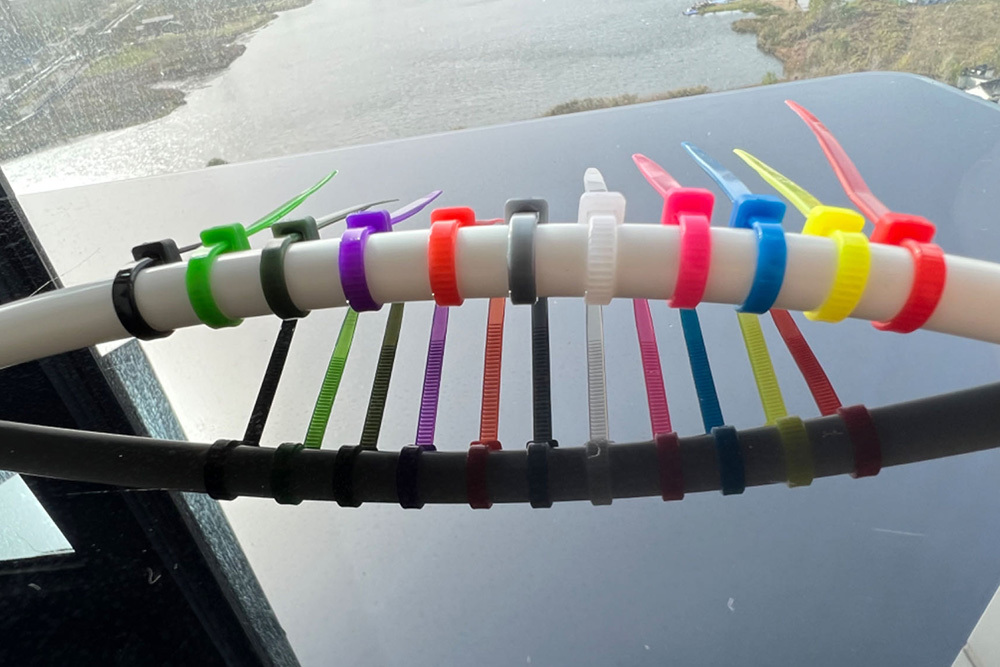16
2025
-
07
How to use plastic cable ties?
Author:
How to Use Plastic Cable Ties Effectively
Plastic cable ties are versatile tools for securing, organizing, and fastening objects in residential, industrial, and commercial settings. Proper usage ensures durability and prevents damage to materials. Below are step-by-step guidelines and best practices for maximizing their functionality.
Preparing for Installation
Before applying a cable tie, assess the environment and materials to avoid common pitfalls:
- Surface Inspection: Ensure the bundling area is free of sharp edges, moisture, or chemicals that could degrade the tie. For example, securing cables near battery acid requires corrosion-resistant ties.
- Bundle Sizing: Measure the diameter of the items to be secured. Over-tightening a tie on a small bundle wastes material, while an undersized tie may snap under tension.
- Tool Readiness: While most ties can be tightened manually, heavy-duty applications benefit from tensioning tools that apply consistent pressure without over-crimping.
For irregularly shaped objects, such as hoses or pipes, use multiple ties spaced evenly to distribute stress. This prevents localized pressure points that could cause deformation.
Step-by-Step Application Process
Follow these steps to ensure a secure and professional finish:
- Thread the Tie: Insert the pointed end of the tie through the ratchet head, leaving enough slack to wrap around the bundle. For flat surfaces, align the tie parallel to the edge to minimize protrusion.
- Position the Bundle: Hold the items together firmly to prevent shifting during tightening. In dynamic environments, like automotive wiring harnesses, use zip-tie mounts or adhesive bases for added stability.
- Tighten Gradually: Pull the tail through the ratchet until snug, then apply gentle pressure to engage the locking mechanism. Avoid yanking abruptly, as this can weaken the tie or damage delicate materials like fiber-optic cables.
- Trim Excess Material: Use diagonal cutters or scissors to trim the tail flush with the ratchet head. Leaving sharp edges risks injury or snagging on clothing.
For reusable ties, locate the release tab on the ratchet head and press it while pulling the tail backward. This feature is useful for temporary installations, such as event setups or seasonal decorations.
Common Mistakes to Avoid
Improper handling can reduce the lifespan of cable ties or compromise safety:
- Over-Tightening: Applying excessive force strains the ratchet teeth, leading to premature failure. A good rule is to stop tightening when the tie feels firm but still allows slight movement.
- Reusing Single-Use Ties: Standard nylon ties are designed for permanent fastening. Attempting to reuse them weakens the locking mechanism, increasing the risk of slippage.
- Ignoring Environmental Factors: UV exposure, extreme temperatures, or chemical contact can degrade ties over time. For outdoor use, select ties with UV stabilizers or weather-resistant coatings.
In high-vibration environments, such as machinery or vehicles, pair ties with cable clamps or loom tubing to dampen movement and prevent abrasion.
Advanced Techniques for Specialized Applications
For complex or high-stakes scenarios, these strategies enhance performance:
- Ladder Bundling: Stack multiple ties in a staggered pattern to create a secure ladder-like structure. This method is ideal for organizing large cable bundles in data centers or control panels.
- Tension Distribution: When securing heavy loads, use two or more ties in parallel, spaced 5–10 cm apart. This prevents concentrated stress on a single tie, reducing the likelihood of breakage.
- Color-Coding Systems: Assign different colors to specific functions (e.g., red for power cables, blue for data lines) to streamline maintenance and troubleshooting. Ensure colorfastness by choosing ties tested for fading resistance.
For applications requiring frequent adjustments, consider ties with adjustable sliding locks or pre-inserted screws for quick repositioning without cutting.
By mastering these techniques and avoiding common errors, users can leverage plastic cable ties as reliable, cost-effective solutions for a wide range of fastening and organizational needs.
plastic cable ties
Hot News
2025-07-18
Circular binding method with plastic cable ties
Plastic cable ties are versatile tools for creating secure loops around cylindrical or irregularly shaped items. Mastering circular binding ensures stability in applications ranging from organizing cables to securing hoses or tools.
2025-07-18
Hidden binding techniques for plastic cable ties
Plastic cable ties are widely used for securing items, but visible ties can disrupt aesthetics in design-focused projects or cluttered spaces. Mastering hidden绑扎 (binding) methods ensures functionality without compromising visual appeal.
2025-07-17
Quick binding steps for plastic cable ties
Plastic cable ties are essential for organizing cables, securing bundles, or fastening objects efficiently. Mastering quick绑扎 (binding) techniques ensures projects are completed faster while maintaining strength and reliability. Below are clear, actionable steps for rapid and effective use.
2025-07-17
Precautions for using plastic cable ties at high temperatures
Plastic cable ties are widely used for securing and organizing items, but their performance can degrade under extreme heat. To ensure safety and functionality, users must account for material properties, environmental factors, and application-specific demands when operating in high-temperature settings.

